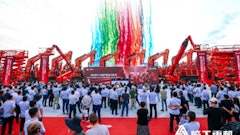
U.S. construction indicators remain stable and contractors continue to view renting as a highly cost-effective means of equipment acquisition. The industry has been growing steadily for the past several years and that trajectory shows no signs of changing direction in the foreseeable future.
While the rate of growth has slowed somewhat over the past few months, analysts assure industry observers the equipment rental market will remain in a growth mode for the next several years at least. That, plus a price-conscious customer base eager to add new models that can earn a speedy and sizable return on investment, suggests equipment manufacturers should put a renewed emphasis on designing simpler, lower-cost models when developing new products.
Growth predicted through 2020
The latest five-year forecast for the equipment rental market projects a compound annual growth rate in revenue of 4.9 percent to reach $57.3 billion in the United States in 2020, according to the American Rental Association’s latest prediction released in August. Projections show industry revenue to increase by 4.9 percent in 2016 to a record $47.6 billion and to grow another 4.6 percent in 2017 to reach $49.8 billion.
The forecast shows steady revenue growth from 2016 through 2020 of between 4.6 and 5 percent each year. What’s more is the equipment rental industry continues to expand at more than double the rate of Gross Domestic Product (GDP) growth.
Scott Hazelton, managing director, IHS Economics, notes the U.S. rental market’s economic growth in the first half of 2016 has been tempered somewhat due to uncertain growth overseas and the increasing value of the dollar, but the future looks bright.
“This also has been exacerbated by uncertainty surrounding future policy direction from a muddled presidential campaign season,” he says. “However, construction remains strong, particularly in the residential sector. While nonresidential growth is slowing, we remain on track for another year of solid gains and consumer spending also remains strong. The slight adjustment in the forecast growth reflects the weaker view for U.S. energy and manufacturing, while the still-strong growth reflects the fact that the economic and construction fundamentals remain positive.”
Meanwhile, contractors have woken up – some say permanently - to the benefits of renting: a cleaner balance sheet, no maintenance or repair costs, no transportation challenges and no insurance expenses, to name just a few. Currently, 52.9% of equipment on U.S. jobsites is rented.
“There is no doubt that the secular shift to renting equipment continues in the markets those in the equipment rental industry serve,” says Christine Wehrman, ARA’s CEO and executive vice president. “Rental companies are adept at identifying customers and relocating equipment to different areas to take advantage of increased demand.”
Shifting equipment from energy to construction applications
The slowdown in oil and gas drilling, resulting from the high-supply and low-demand environment, which in turn has driven down the price of oil, has impacted the utilization of both dealer rental and general rental fleets, but as Wehrman notes, those in the industry are adapting.
According to industry sources, the reduced activity surrounding new well activity has impacted distributors, contractors and rental companies in areas with a higher concentration of energy production. The positive news in these areas is that as equipment comes off of production jobs in energy, it has been absorbed into other construction-related activities. The downside to this is there has been recent pressure on pricing for non-energy related projects as well as downward pressure on rental rates and used equipment rates for assets related to the energy industry. The future of U.S. energy markets remains speculative, but there appears to be sufficient activity in other markets to absorb the loss of energy-related activity in the rental industry.
Glut of used equipment impacts manufacturers
Despite the economic recovery, many rental companies still have a large amount of aged equipment left over from the down years when they kept units in fleet past their typical life cycle. Those machines are now entering the already crowded secondhand market, creating challenges for equipment makers faced with slack demand from customers.
Many construction firms and other equipment users are renting or entering longer-term leases for machines to expand their fleets or replace worn out equipment in lieu of buying pricier new models, analysts say. It’s interesting to note that rental businesses account for just over half of new equipment sales in the U.S., and some analysts see that climbing to 60% within five years.
Meanwhile, dealers are keeping smaller inventories of new machinery, hurting sales for major manufacturers such as Caterpillar, Volvo, Deere and others. Add the fact that the strong U.S. dollar is dampening demand from developing African and Asian markets that once snapped up used machines, and it’s easy to see why the availability of inexpensive used equipment remains high, presenting buyers with yet another attractive alternative to buying new. The offer gets even sweeter when you consider that used machinery prices are down 10% from a year ago.
If you build it, they will come
With all of these factors at play, equipment manufacturers stand to benefit from offering a greater selection of new models that meet the various demands from divergent customer bases. We know, for example, that many rental companies are looking for a simpler, lower-cost alternative to premium machines with all the latest bells and whistles. Others, however, need to have the latest technology if their particular customer base demands it. Still others want a happy medium, and some manufacturers are working toward offering a little of everything.
The common goal for all rental buyers is to achieve the highest ROI while offering customers a simple-to-use machine with minimal Tier 4 maintenance requirements. With that in mind, many manufacturers are introducing models powered by 74-hp engines that eliminate maintenance-related activities associated with the more advanced systems found in machines rated higher than 75 horsepower.
Of course, performance is key, so equipment makers can’t go too far in compromising the engine and associated technology. On the other hand, it is possible to eliminate a certain amount of electronics and control systems without sacrificing the machine’s essential capacities. At the end of the day, rental businesses value machines that can offer their customers the performance they need but without the extras that drive up the price of the equipment.
Rental has become such a force that equipment manufacturers are already a few years deep into this trend toward designing models specifically for that market, with less emphasis on high-tech features and a greater focus on simplicity, durability and a faster return on investment. As rental continues to gain momentum among equipment users, there’s an opportunity for manufacturers to offer these buyers competitively priced, stripped down models with lower-horsepower engines but comparable performance. Throw in the threat of low-priced off-shore brands inching their way into the market and it becomes an imperative for manufacturers to make a renewed commitment to including simpler, “economy” models – as well as mid-tier and premium options - in their product line if they want to win business in today’s equipment market.




















![Building Angled Sm Edit 6050b8d213f1b[1]](https://img.forconstructionpros.com/mindful/acbm/workspaces/default/uploads/2025/09/building-angled-sm-edit6050b8d213f1b1.Ygq5aAos3b.png?ar=16%3A9&auto=format%2Ccompress&crop=focalpoint&fit=crop&fp-x=0.53&fp-y=0.23&fp-z=2&h=135&q=70&w=240)